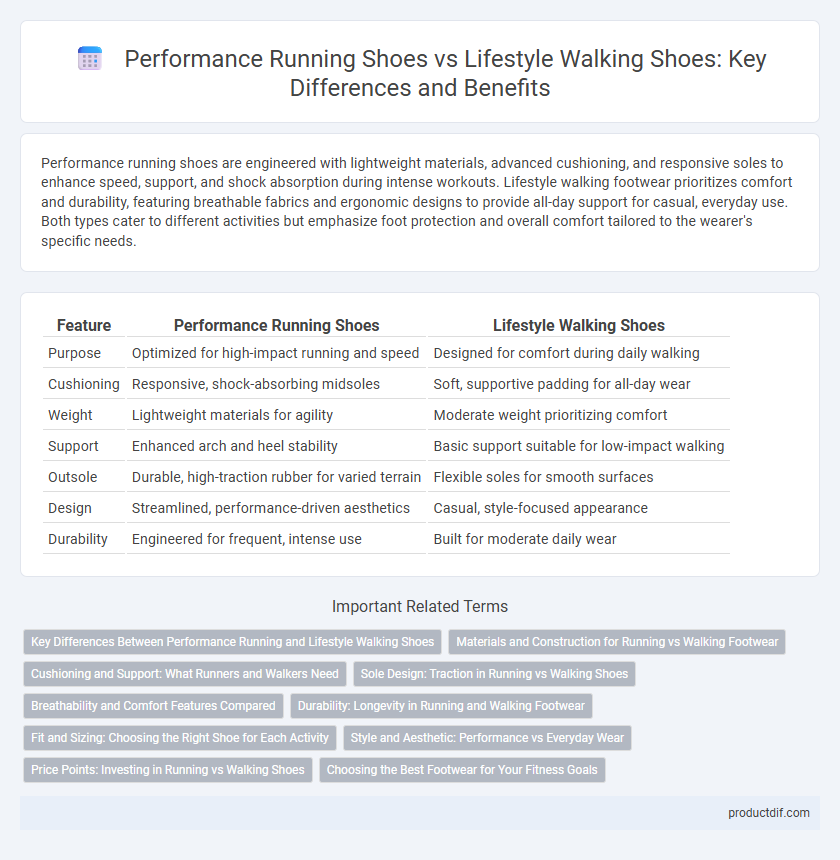Performance running shoes are engineered with lightweight materials, advanced cushioning, and responsive soles to enhance speed, support, and shock absorption during intense workouts. Lifestyle walking footwear prioritizes comfort and durability, featuring breathable fabrics and ergonomic designs to provide all-day support for casual, everyday use. Both types cater to different activities but emphasize foot protection and overall comfort tailored to the wearer's specific needs.
Table of Comparison
| Feature | Performance Running Shoes | Lifestyle Walking Shoes |
|---|---|---|
| Purpose | Optimized for high-impact running and speed | Designed for comfort during daily walking |
| Cushioning | Responsive, shock-absorbing midsoles | Soft, supportive padding for all-day wear |
| Weight | Lightweight materials for agility | Moderate weight prioritizing comfort |
| Support | Enhanced arch and heel stability | Basic support suitable for low-impact walking |
| Outsole | Durable, high-traction rubber for varied terrain | Flexible soles for smooth surfaces |
| Design | Streamlined, performance-driven aesthetics | Casual, style-focused appearance |
| Durability | Engineered for frequent, intense use | Built for moderate daily wear |
Key Differences Between Performance Running and Lifestyle Walking Shoes
Performance running shoes prioritize lightweight materials, advanced cushioning systems, and enhanced arch support to optimize speed, shock absorption, and injury prevention during high-impact activities. Lifestyle walking shoes emphasize comfort, durability, and stylish designs suitable for everyday wear, featuring softer midsoles, increased sole flexibility, and breathable uppers tailored for prolonged walking. The key differences lie in sole construction, weight, and technology integration, with running shoes designed for biomechanical efficiency and walking shoes focused on casual comfort and support.
Materials and Construction for Running vs Walking Footwear
Performance running footwear features lightweight, breathable mesh uppers combined with responsive, cushioned midsoles such as EVA or TPU foams to enhance energy return and impact absorption during high-intensity activity. Lifestyle walking shoes prioritize durable, flexible materials like leather or knit fabrics, paired with stable rubber outsoles and supportive arch designs for comfort and long-term wear. The construction of running shoes often includes reinforced heel counters and advanced lacing systems for secure fit, while walking shoes emphasize ergonomic footbeds and shock-absorbing insoles to reduce fatigue during extended use.
Cushioning and Support: What Runners and Walkers Need
Performance running footwear prioritizes advanced cushioning systems like EVA foam and responsive gel to absorb high-impact forces and protect joints during intense, repetitive strides. Lifestyle walking shoes emphasize moderate cushioning combined with arch support and stability features to provide comfort and reduce fatigue over extended periods of casual movement. Understanding the specific biomechanical demands, runners require dynamic support for propulsion whereas walkers benefit from balanced support aimed at maintaining foot alignment and comfort during steady, low-impact gait cycles.
Sole Design: Traction in Running vs Walking Shoes
Running shoes feature soles with multidirectional traction patterns designed to provide maximum grip and stability during high-impact, rapid movements on varied terrains. Walking shoes prioritize flat, flexible soles with strategically placed traction zones that enhance comfort and smooth heel-to-toe transitions on even surfaces. The sole design in performance running shoes emphasizes shock absorption and propulsion, whereas lifestyle walking shoes focus on durability and consistent ground contact.
Breathability and Comfort Features Compared
Performance running shoes incorporate advanced breathable mesh fabrics and engineered ventilation zones that optimize airflow and moisture management during intense activity. Lifestyle walking footwear prioritizes cushioned insoles and softer materials to enhance comfort for extended daily wear, often using padded collars and memory foam midsoles. Breathability in performance shoes is designed to maintain foot temperature and reduce sweat, while lifestyle shoes focus on all-day comfort and support.
Durability: Longevity in Running and Walking Footwear
Performance running shoes prioritize advanced materials like reinforced mesh and carbon-infused midsoles to withstand high-impact forces and repetitive motion, enhancing durability for long-distance training. Lifestyle walking shoes emphasize durable outsoles made of rubber compounds with increased abrasion resistance to support daily wear without compromising comfort. Longevity in running footwear depends heavily on cushioning breakdown and structural integrity, whereas walking shoes focus more on sustained outsole grip and upper material resilience during low-impact use.
Fit and Sizing: Choosing the Right Shoe for Each Activity
Performance running shoes prioritize a snug, secure fit with enhanced arch support and cushioning to optimize shock absorption and prevent injuries during high-impact activities. Lifestyle walking shoes offer a more relaxed fit with ample room in the toe box and flexible soles to accommodate natural foot movements and all-day comfort. Selecting the right fit and sizing ensures maximum performance and reduces the risk of blisters or discomfort tailored to each specific activity.
Style and Aesthetic: Performance vs Everyday Wear
Performance running shoes prioritize lightweight materials, streamlined designs, and vibrant color accents to enhance athletic efficiency and visual dynamism. Lifestyle walking footwear emphasizes versatile aesthetics, combining comfort-focused construction with subtle, timeless style elements suitable for everyday wear. The distinction lies in performance-driven tech features versus fashion-forward adaptability for casual environments.
Price Points: Investing in Running vs Walking Shoes
Performance running shoes typically range from $100 to $250, offering advanced cushioning, support, and durability designed for high-impact activity and long-distance running. Lifestyle walking shoes are generally priced between $50 and $150, emphasizing comfort and casual style for everyday wear without the need for specialized performance features. Investing in running shoes supports injury prevention and enhanced athletic performance, while walking shoes prioritize affordability and versatility for daily use.
Choosing the Best Footwear for Your Fitness Goals
Selecting footwear tailored to your fitness goals enhances both comfort and efficiency; performance running shoes feature advanced cushioning, breathability, and support designed to absorb impact and improve speed. Lifestyle walking shoes prioritize lightweight construction, flexibility, and arch support, ensuring all-day comfort during low-impact activities. Understanding your activity type and foot biomechanics aids in choosing the best footwear for injury prevention and optimal performance.
Performance running vs Lifestyle walking Infographic

 productdif.com
productdif.com